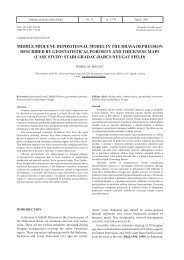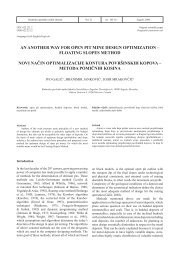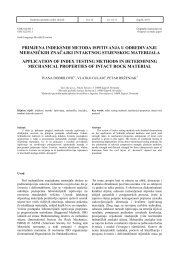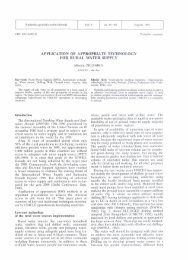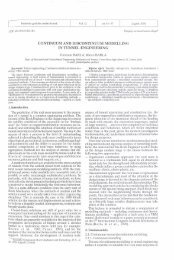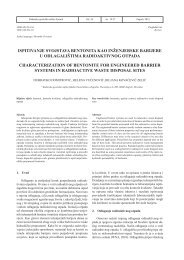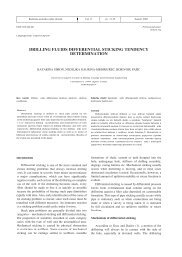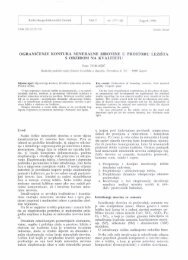quarry stability analysis for complex slip surfaces using the ...
quarry stability analysis for complex slip surfaces using the ...
quarry stability analysis for complex slip surfaces using the ...
You also want an ePaper? Increase the reach of your titles
YUMPU automatically turns print PDFs into web optimized ePapers that Google loves.
94<br />
Rud.-geol.-naft. zb., Vol. 16, Zagreb, 2004.<br />
P. Hrženjak: Quarry <strong>stability</strong> <strong>analysis</strong> <strong>for</strong> <strong>complex</strong> <strong>slip</strong> <strong>surfaces</strong>...<br />
<br />
<br />
<br />
<br />
<br />
<br />
<br />
<br />
<br />
<br />
<br />
Figure 3. Profile of <strong>the</strong> <strong>quarry</strong> Vukov Dol<br />
Slika 3. Profil kamenoloma Vukov Dol<br />
The <strong>quarry</strong> Pregrada<br />
The second example of <strong>the</strong> slope <strong>stability</strong> <strong>analysis</strong><br />
<strong>for</strong> <strong>the</strong> project solution was carried out <strong>for</strong> <strong>the</strong> <strong>quarry</strong><br />
Pregrada. The <strong>quarry</strong> Pregrada is placed in <strong>the</strong> North-<br />
West part of <strong>the</strong> Republic Croatia. The rock mass of <strong>the</strong><br />
<strong>quarry</strong> Pregrada is mostly Triassic dolomite. The total<br />
height of <strong>the</strong> <strong>quarry</strong> amounts to about 210 m. Based<br />
on <strong>the</strong> geological characteristics of <strong>the</strong> rock mass, <strong>the</strong><br />
<strong>quarry</strong> is divided in two regions. The first region, marked<br />
as <strong>the</strong> Dolomite I, stretches from <strong>the</strong> elevation +205 to<br />
approximately +310 m and <strong>the</strong> second region, marked<br />
as Dolomite II, stretches from +310 to +415 m. The<br />
geometry of <strong>the</strong> slope is illustrated in figs. 4 and 5 that<br />
show <strong>the</strong> 210 m high slope with fourteen 15 m high<br />
benches. The inclination of <strong>the</strong> individual bench face is<br />
65° and <strong>the</strong> overall slope angle is about 42,6°.<br />
Dolomite I is represented by dark grey dolomite with<br />
a density of 2769 kg/m3, GSI=49, σ ci<br />
=60 MPa and m i<br />
=11.<br />
Dolomite II is represented by light grey dolomite, light<br />
yellow lime-dolomite and dolomite breccia with a density<br />
of 2769 kg/m3, GSI=53, σ ci<br />
=88 MPa and m i<br />
=8. By <strong>the</strong><br />
Hoek-Brown failure criterion <strong>the</strong> average cohesion of<br />
0,679 MPa and <strong>the</strong> degree of internal friction of 26,6° <strong>for</strong><br />
Dolomite I, as well as <strong>the</strong> average cohesion of 0,844 MPa<br />
and <strong>the</strong> degree of internal friction of 29° <strong>for</strong> Dolomite II<br />
were obtained.<br />
The discontinuities which can influence <strong>the</strong> <strong>stability</strong> of<br />
<strong>the</strong> <strong>quarry</strong> are: discontinuity with an angle of inclination<br />
of 31°, <strong>for</strong> <strong>the</strong> first region, Dolomite I, and discontinuity<br />
with an angle of inclination of 43°, <strong>for</strong> <strong>the</strong> second region,<br />
Dolomite II. The characteristics of <strong>the</strong> first discontinuity<br />
are JRC=4÷8, JCS=32÷35 MPa and ϕ b<br />
=30°. The<br />
characteristics of <strong>the</strong> second discontinuity are JRC=8÷12,<br />
JCS=82÷88 MPa and ϕ b<br />
=30°. The persistence of <strong>the</strong><br />
discontinuities varies from 20 to 30 m, but may be up to<br />
50 m in special cases.<br />
The slope <strong>stability</strong> <strong>analysis</strong> has been per<strong>for</strong>med<br />
<strong>for</strong> a number of cases. For <strong>the</strong> first case, <strong>the</strong> <strong>stability</strong><br />
<strong>analysis</strong> was carried out without any discontinuities and<br />
<strong>the</strong> factor of safety of 1,876 was obtained (fig. 4). For<br />
<strong>the</strong> second case, <strong>the</strong> <strong>stability</strong> <strong>analysis</strong> was carried out<br />
with discontinuities and <strong>the</strong> factor of safety of 1,854<br />
was obtained. It is obvious that <strong>the</strong>re is no significant<br />
difference in <strong>the</strong> obtained values of safety factors <strong>for</strong> <strong>the</strong>se<br />
cases. This is due to <strong>the</strong> relatively good characteristics<br />
and small lengths of discontinuities, but <strong>for</strong> <strong>the</strong> reduced<br />
shear strength of discontinuities, <strong>for</strong> example, <strong>for</strong> <strong>the</strong><br />
cohesion of 10 kPa and angle of internal friction of 17°<br />
and length of discontinuity of 50 m, <strong>the</strong> factor of <strong>stability</strong><br />
falls to 1,576 (fig. 5).<br />
Ano<strong>the</strong>r important feature of <strong>the</strong>se analyses is<br />
that changes of characteristics of rock mass and<br />
discontinuities, beside <strong>the</strong>ir influence on <strong>the</strong> safety factor,<br />
have a significant influence on <strong>the</strong> position of <strong>the</strong> critical<br />
<strong>slip</strong> surface. This is obvious from shapes of <strong>the</strong> <strong>slip</strong><br />
surface in figs. 4 and 5.



